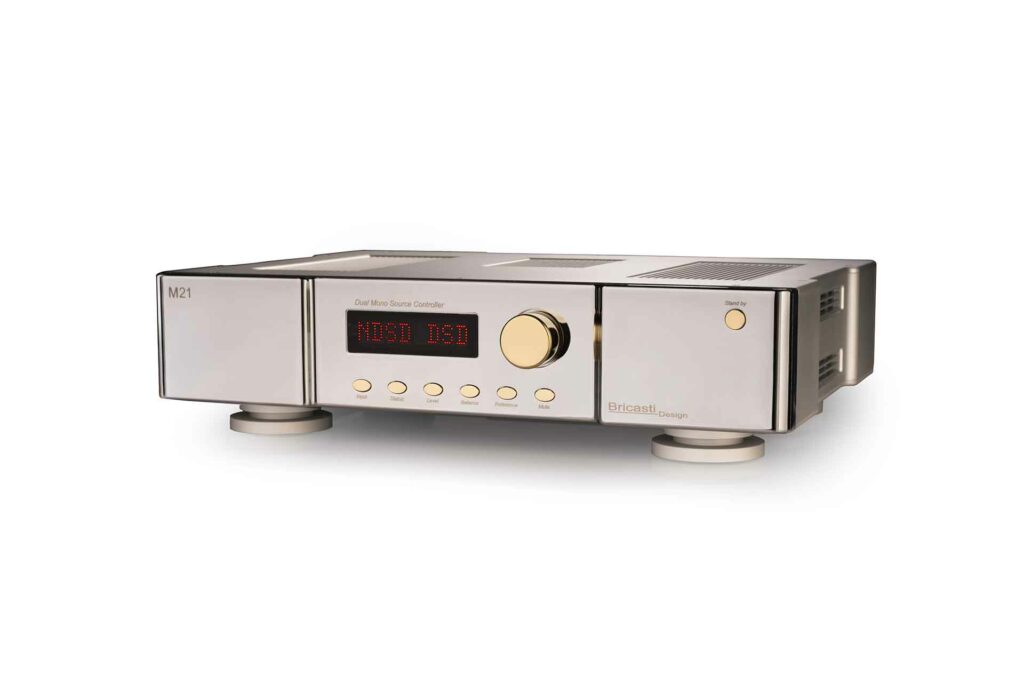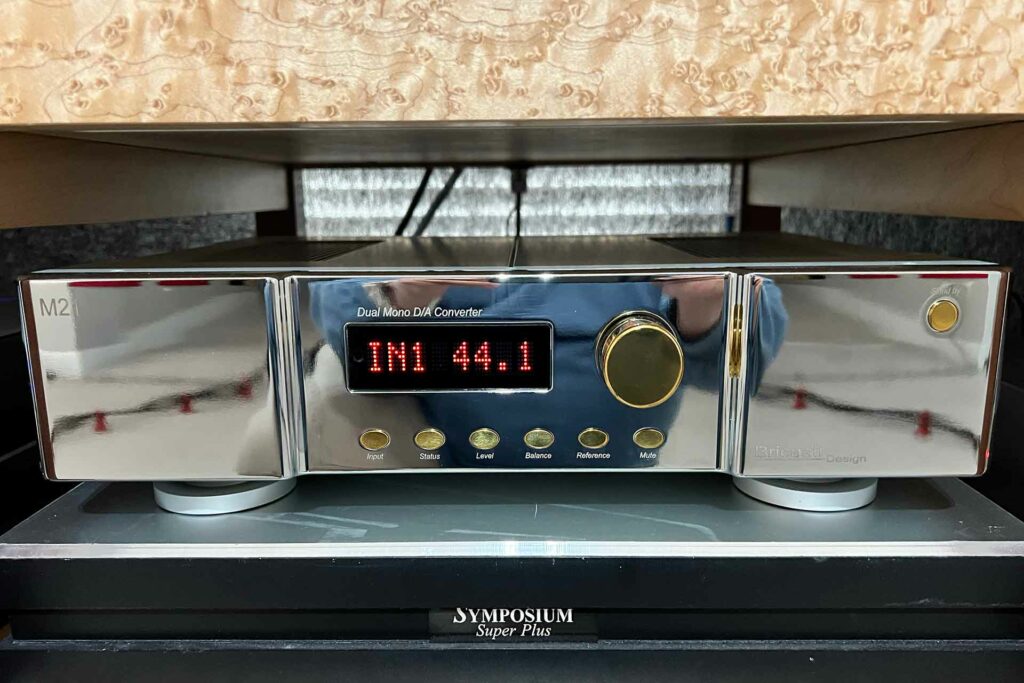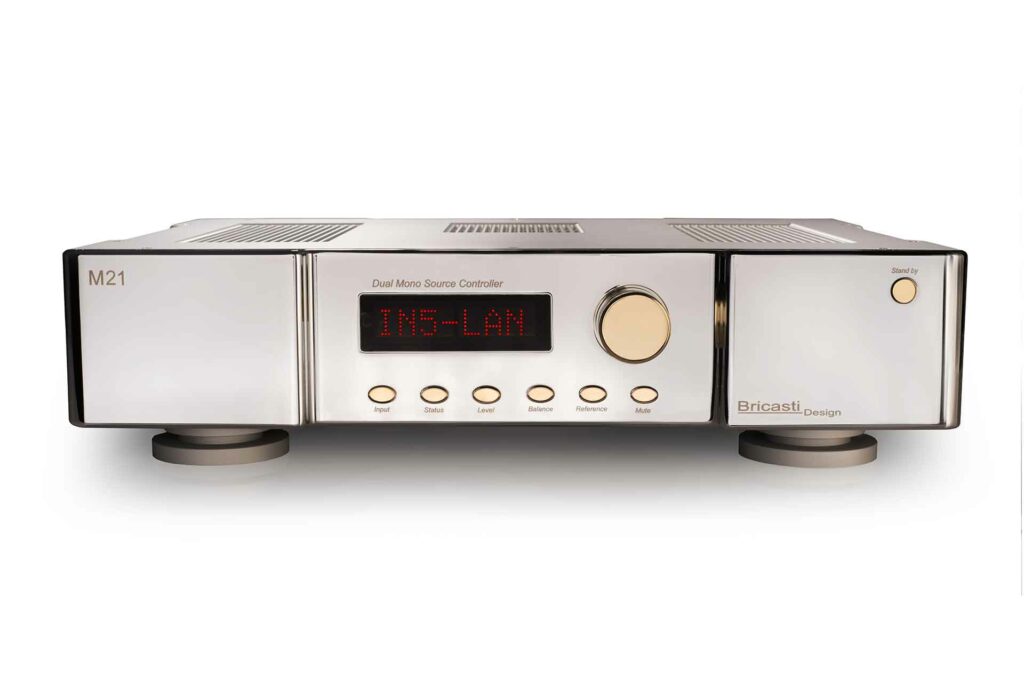Bricasti Design was founded in 2004 by two executives formerly associated with Lexicon. Bricasti’s initial focus was on the pro audio side, and the company immediately gained a solid reputation thanks to its M7 reverb unit. Before long, Bricasti turned to consumer components and today offers audiophiles preamps, stereo and monoblock amps, source controllers, network players, and audiophile DACs. Engineering practices and designs in the pro audio sector have been carried over into consumer products, making Bricasti a very well-respected name. In this review, we take a closer look at the company’s flagship DAC for home audio, the $19,000 Bricasti M21 Platinum Series.

What Makes the Bricasti M21 Platinum Series DAC Special?
- At first glance, its appearance is absolutely beautiful. With the highly polished, quite nearly mirror finish and the brass-plated buttons, the M21 Platinum Series looks eminently sophisticated in any audio system. The entire case is made from machined aluminum, adding a solid feel and respectable heft to the unit. Even the weighty aluminum remote is highly polished with brass buttons.
- The system architecture of this DAC is dual isolated differential channels with two linear power supplies, effectively eliminating analog crosstalk and ensuring the unit has an amply power reserve. This is a feature, believe it or not, more commonly found on DACs costing much more than the M21.
- There are six available digital inputs to handle almost any connection. These include AES/EBU, S/PDIF (both RCA and BNC), USB, Toslink, and a LAN network connection. Analog outputs are left and right balanced XLR or single-ended RCA terminals.
- There are three DAC chipsets available for use in the M21. For PCM playback, one choice is a ladder DAC and, for both PCM and DSD, a Sigma Delta DAC. Exclusive to DSD, a third option is a proprietary Bricasti-designed one bit modulator DAC.
- The PCM DAC chipsets feature two filter settings. One is a minimum phase and the other is a linear phase. Having these options and multiple DAC settings enables the listener to craft their own sound, at least to a point.
- By using 8-Times oversampling in PCM and then applying anti-aliasing filters, the Bricasti M21 DAC effectively reduces noise and distortion thereby improving sonics.When the one-bit DSD modulator is selected, there is no digital filtering, so no oversampling takes place.
- The Bricasti M21 DAC can easily function as a standalone DAC when paired with a preamp or provide volume attenuation when directly connected to an amplifier. Source selection could not be any easier. Setting the level to 0dB automatically places the unit in a hard wire bypass mode, which facilitates usage as a pure DAC with volume controlled by the preamp. When directly connected to an amplifier, level adjustment may be made by the remote or the round knob on the front faceplate. This knob is completely fluid and almost effortless in operation, and provides amplitude adjustments from -90dB to 0dB and 0dB to +6dB.
- There is an LED display screen conveniently large enough to read from across the room. This display may be adjusted to three level of brightness or turned off completely. In the Off mode, the display illuminates when a setting is changed, then turns off after the selection has been completed.
- Pressing the Status button on the front faceplate or the remote will access the user-controlled settings. These settings include, among others, input selection and playback resolution, one of the two PCM DAC chips, PCM filter settings, DSD conversion, level adjustment, phase invert (digital domain of PCM only, not DSD), and something seldom seen on any component: the internal operating temperature.
- DAC technology is constantly changing and the Bricasti M21 is adaptable to those changes. Bricasti periodically offers software upgrades to advance current technology or other performance improvements. These upgrades commonly come in the form of a flash drive that connects to the M21 and may be user upgraded.
Why Should You Care About the Bricasti M21 Platinum Series DAC?
Aside from the company’s pro audio heritage, using the Bricasti M21 Platinum Series not only will make a system more visually appealing, it also gives the user the flexibility to control certain aspects of audio reproduction that aren’t usually accessible. This enables the listener to craft their own sound, at least marginally.
Sonically, the Bricasti M21 DAC is an exceptional audiophile component with outstanding performance. It easily punches well above its weight class and, at $19,000, that is saying something.

Some Things You Might Not Like About the Bricasti M21 DAC
- Not everybody will love the shiny look and Bricasti has that covered with a non-Platinum Series finished more like their standard components in a matte black box.

Listening With the Bricasti M21 Platinum Series DAC…
After spending some time fiddling with the various options, I found the ladder DAC with the linear phase filter sounded more lively and musically pleasing. This compared to a more subtle presentation using the Sigma Delta DAC. Kudos to Bricasti for having these options.
Immediately, I noticed a richness in terms of overall musical presentation. Tonality and timber were very natural sounding in this setting. Dynamics were simply excellent and equally on par with what I have always experienced with my system with my nearly-$30,000 but 10-year-old Esoteric DAC. Clarity and accuracy with the Bricasti were spot on versus the many DACs that I’ve auditioned in my room in the past week or two – and that’s been quite a few high-end DACs.
One of two very noticeable traits was an incredible reproduction of detail. The Bricasti M21 DAC is a champ at sussing out fine levels of detail and, in my case, musical cues previously unheard. On a surprising number of my favorite songs, a playlist now numbering about 150, I noticed transient detail previously not heard even with very high-end digital components in my system. These new revelations ranged from, say, a subtle chord change to an instrument I had no idea was even in the mix.
The second of my more notable findings was markedly improved imaging compared to what I have historically heard in my system. Imaging ranks very high in my list of sonic attributes and by any estimation is very challenging to faithfully create. The Bricasti M21 DAC handled this undertaking effortlessly, rendering excellent imaging both side-to-side and front-to-back. Also noticeable was how the various instruments were very specifically placed in the soundstage.
On the 44.1/16 CD version (copied to music server) of The Four Tops – The Ultimate Collection, the song “Reach Out (I’ll Be There)” is one of many songs showcasing the incredible voice of Levi Stubbs. As presented by the Bricasti M21, Stubbs’ voice comes through with all the power and emotion for which he is so well known. Easily heard is the pleading, almost angst-driven tonality in his singing. With the M21, Motown’s arrangements and the excellent musicianship of The Funk Brothers are easily heard and understood. With the clarity and accuracy of the M21 even this decades-old recording sounds excellent.
Listening to Post Malone’s “Circles” from his Hollywood’s Bleeding album (44.1/16 CD copied to server), the opening has a low and powerful bass and drum line that on my system sounded very tight, precise, and dynamic. Quite surprising was the drum intro. Separately identifiable from the bass, it had a resonance just like hitting a drum live. There was also a surprising separation of instruments – something I have come to learn the M21 accomplishes exceptionally well.
Does the Bricasti M21 Platinum Series DAC Have Any Resale Value?
One need only look at the variety of used audio gear websites to find Bricasti products are not very plentiful. Generally speaking, they tend to stay with their first owners. So assessing a true value proposition for the used market is somewhat difficult. In a quick check online, I found only a few Bricasti DACs and only one M21, and it was not the Platinum Series. All were selling for more than half their retail price so, yes, resale proposition should be very good. Bricasti’s amazing upgrade history in the DAC world also adds to their long-term appeal and value.
Who Is the Competition for the Bricasti M21 Platinum Series DAC?
There are any number of $20,000 DACs available. Rather than limiting myself to that price range, though, I thought it would be interesting to specifically examine four DACs at four different price points to see how sonically close they were to each other – or how far apart. (Note: reviews are coming for all of these DACs from yours truly).
- Compared to the PS Audio Direct Stream DAC II ($7,995) the Bricasti M21 was not surprisingly a step above. The PS Audio was exceptionally detailed and, like the M21, offered excellent imaging, especially lateral side placement of instruments. What the M21 brought to the party was a richness and warmth that noticeably bettered the DAC II. The M21 also exceeded the DAC II’s retrieval of detail and transients. While the M21 is a superior product, it is a legitimate question to ask if the differences are worth more than twice the cost. And the answer lies in the system itself. Upper echelon systems will champion the M21’s superior sonics. Budget systems will likely enjoy the more competitive cost and noticeable improvements brought forth by the DAC II. It is also an exceptional sounding DAC.
- Compared to the Meitner MA3 ($10,500), the M21 also delivered a warmer, richer, more euphonic sound. The Meitner MA3 has a relaxed sound, enabling an all-day listening session with no fatigue, even at 80dB levels or above. While the Bricasti M21 had a slightly more intense presentation when using the ladder DAC, the Sigma Delta DAC inside the Bricasti M21 Platinum sounded a touch warmer, softer, more laid-back. Having these multiple DAC chip options on the M21 and not on the MA3 is one of the more notable differences.
- Lastly, and the most interesting comparison, how does the Bricasti M21 compare to the T+A SD3100HV? This was a very difficult comparison. The T+A SD3100HV ($36,300) had a very precise, full, and dynamically robust presentation, making it highly listenable. The Bricasti M21 DAC was equally detailed, and, while slightly less analytical and precise, rendered an improved degree of richness of tonality and warmth. I also noticed the M21 had slightly wider imaging. Deciding on a preference was decidedly difficult. I liked certain things about each one more so than the other. It does seem worthwhile to note that the Bricasti M21 is just under half the cost of the T+A SD3100HV. And while the T+A DAC has substantially more features, world class engineering, and build quality, the user must decide if it is worth the extra cost.
In comparing these four DACs, I was surprised at how far apart they were in price and surprisingly close they were in performance. All have their specific attributes worthy of note, and none are bad performers by any measure. They each have their own level of system into which they best fit. They all will satisfy a wide range of large audiophile budgets. But it cannot be denied they all performed, at a minimum, admirably in my system. Some obviously better (or more to my tastes) than others.

Final Thoughts on the Bricasti M21 Platinum Series DAC…
I found the Bricasti M21 Platinum Series to be a very musical product, successfully elevating my listening experience over and above the legacy Esoteric DAC I have been using for about 10 years. The Bricasti M21 is a user-friendly component with easily understandable system settings. In my rig, it produced incredible detail and imaging, powerful dynamics, and an almost you-had to-be-there sense of musicality.
My biggest problem with the M21 was completely forgetting I was doing a review and allowing myself to get lost in the music. When the room disappears and the sonic presentation sounds so natural, so dynamic, so entertaining, and so engaging, it was easy to forget to take notes. And since the only change in my system was the Bricasti M21, there is no other choice than to attribute that to the DAC.
Reviewers and consumers alike have caught onto the technical and sonic merits of Bricasti gear across their entire product line – preamps, power amps, and DACs alike. While not priced as expensively as other world-class products such as Wadax, D’Agostino, T+A, CH Precision, Constellation, dCS, or other uber-audiophile products, Bricasti is no less a world-class choice in its own right. Calling a $19,000 DAC a great value might sound entirely ludicrous to many buyers. In my estimation, however, Bricasti equipment not only performs at the highest level possible, but the company’s stellar upgrade program, high resale value, excellent build quality, features, and built-in-America pedigree means writing such a meaningful check feels worth it. With most of the aforementioned high-end audiophile DACs having been on display in my reference room, my check for the M21 was FedExed to Bricasti. That’s how good the Bricasti M21 Platinum Series is.




You wrote:
“On a surprising number of my favorite songs, a playlist now numbering about 150, I noticed transient detail previously not heard even with very high-end digital components in my system. These new revelations ranged from, say, a subtle chord change to an instrument I had no idea was even in the mix.”
I say: “Amen, Brother.”
john
PS: I have found ArgentPur’s pure-silver air-dielectric balanced XLR cables to be VERY synergistic with Bricasti digital gear.
Hey John, thanks for your comment!
I’ve enjoyed my Bricasti M1 Limited Gold DAC for about six years. Paired with the M25 Stereo amplifier, it is a very synergistic pairing.
One thing that I have totally appreciated is the stellar support I’ve received from Bricasti. CEO Brian Zolner has always quickly responded to any questions, and in the instance where I’ve sent the unit in for upgrade, it was returned quickly.
Top notch company.
Paul,
I couldn’t agree more about Bricasti and Brian. He’s a gem.
And people might fall over dead when I say this but even their top of the line stuff is a “value”. By that, I mean that I would put it up versus Solution, CH Precision, D’agostino. Is it better? Possibly. Maybe. But look at the cost difference.
The reviewer bought the $19,000 DAC. So did a friend of his. Paul Wilson recently had the new PS Audio (review coming), T+A’s $36,000+ DAC (he has their other stuff), a $10,000 EMM Labs and this Bricasti. The Bricasti got the check. The T+A was in serious consideration (both 3-chip implementations) but the Bricasti’s value was too good – even at the UBER HIGH END level of things.
I kinda want one like yours or Paul’s (I guess you are Paul too but you get my point)
THANK YOU for the comments. More DAC reviews coming too. T+A, PS Audio’s new top, Benchmark DAC3, Schiit’s top (don’t make me try to type it out as it is like Edmonton Oiler Center Draisaitl)
Hey Paul,
I agree with you about Brian. He is a really nice guy who also happens to be wicked smart. Seems natural their gear is so well designed. I’ve known him for a number of years and always found him to be very open and accessable. I have always liked their gear but this is the first piece I’ve actually owned. And I’m glad I made the purchase.
BTW, soon after receiving my review sample and submitting the review for publication, Bricasti changed the display from the red, “dot” LED they have always used to a more traditional display using black letters / numbers with white background lighting. It looks really cool and is equally easy to see from across the room – a feature I feel is very important. Nobody wants to get up and walk across the room to see the display. I’m sure this is an upgradable feature so mine may be going back at some point!
Thanks for your comment Paul!
Happy Listening…
P
Can I jump in, too? Brian is just an amazing human being, truly. As everyone knows, my entire front-end is Bricasti and I just updated to the M1SII. I got my original M1 as a b-stock unit 10+ years ago, and have made each upgrade Bricasti releases. One can argue right there in regard to the value Bricasti presents. Doing some quick math my cost of ownership on my M1 has been ~$863/yr at retail prices. Hell, one fishing trip for my brother on his boat is $1,200 worth of fuel. So many manufacturers talk about future readiness, and upgradability, but very few follow through.
It is actually a challenge now for me and my audio buddies to find electronics that are better than the Bricasti stuff at the top-end. Many things are different, few just as good, but none as good of a value.